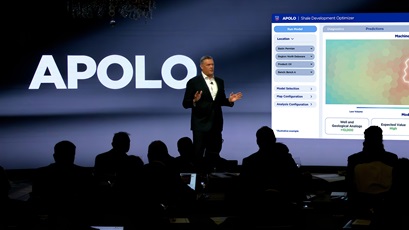our operations
methane detection reaches new heights in angola
2 min read | february 23, 2023
Two workers walk upstairs on a Mafumeria platform located off the coast of Angola.
When Texan Colby Hall moved across the globe to help drive Chevron’s lower carbon progress in Angola, a world of adventure awaited her.
She traveled to places she wouldn’t otherwise have seen, forged friendships with locals, picked up a new language and was immersed in a new culture. Her professional experience as an integrated optimization team lead at Chevron was just as rich.
She recently led a 20-day drone campaign offshore Angola as part of Chevron’s ongoing efforts to find and minimize methane emissions throughout our worldwide operations.
Data gathered from the survey of multiple platforms will be analyzed and used to prioritize our queue of lower carbon projects in Angola, one of Africa’s largest oil producers.
view from above
A results-driven person, Hall finds it exciting to be participating in impactful work.
Her participation in the methane campaign began in July 2021, when she was contacted by a methane detection company via LinkedIn and started working with colleagues internally to bring the technology to Angola.
She helped execute the plan last year by leveraging the experience of Chevron’s asset integrity team as well as existing drone and pilot contracts.
a new adventure awaits
As Hall prepares to relocate with her family to California, she reflected on the progress she’s observed throughout the past several years.
In early 2022, for example, our Angola assets began using an interactive dashboard that displays fuel, venting and flaring data that can be accessed from computers or smart devices. It allows operations, field personnel and management to share, analyze and act based on the data the readings provide.
Actual emissions data are tracked against expected emissions. Differences identify opportunities for further investigation to determine where operational enhancements, equipment adjustments or repairs may be needed, all of which can improve methane emissions performance.
“It’s been a huge shift, and we still have work to do of course, but I’m proud of how quickly we shifted,” Hall said.
colby hall
integrated optimization team lead
taking flight
Chevron has been ramping up methane emission reduction efforts in Angola for the past decade.
Among the newest emission reduction tools at our disposal, drones can help us play a role in the process by:
- Taking new methane emission measurements to compare with documented measurements.
- Gathering data to confirm suspected sources of emissions.
- Performing photo flights to create 3D models for further inspection.
frequent flyers
Chevron uses drones throughout our global operations to improve survey capabilities at elevated and other hard-to-reach locations.
For the first time last year, we deployed sensor-affixed drones to detect methane emissions in the U.S. Gulf of Mexico, becoming one of the first in the industry to do so.
topics covered
related content
-

 how APOLO helps chevron pinpoint prime drilling locations
how APOLO helps chevron pinpoint prime drilling locationsour operationsnovember 12, 2025
-

 robotics supports more efficient workplace
robotics supports more efficient workplaceour operationsnovember 10, 2025
-

 the people who power the US energy advantage
the people who power the US energy advantageour operationsnovember 06, 2025
-

 a statement from chevron CEO mike wirth on Argentina
a statement from chevron CEO mike wirth on Argentinaour operationsseptember 24, 2025
chevron email updates
Subscribe to our newsletter to receive news and updates.



